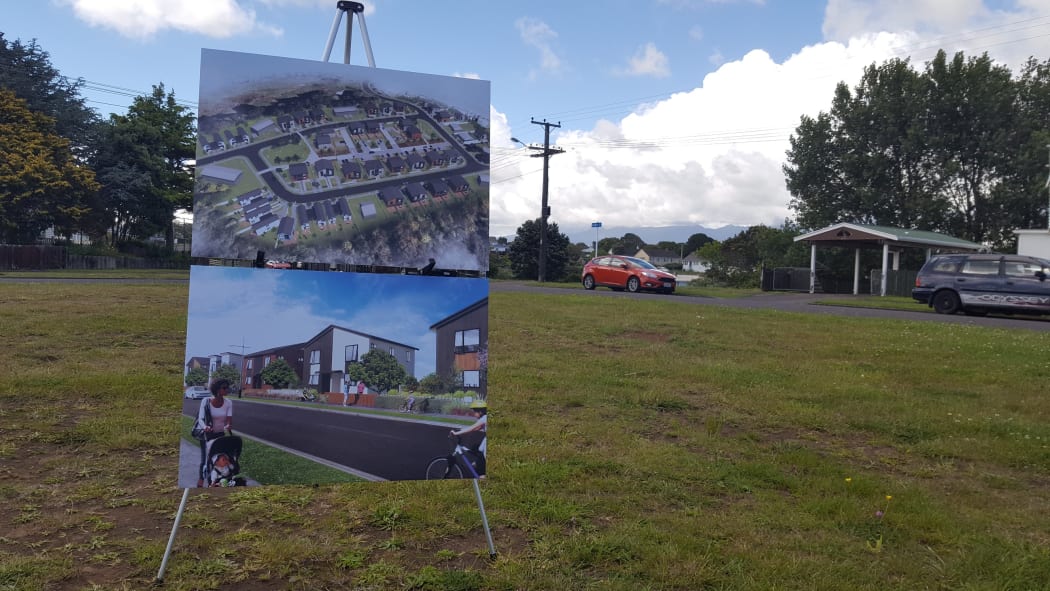
Expectation vs reality. A board displays an artist render of the Marfell KiwiBuild project. Photo: RNZ / Robin Martin
Labour’s Kiwibuild was touted as a solution to a housing crisis borne out of record immigration, demand outstripping supply, rocketing construction costs and soaring house prices.
It hasn’t gone well.
The plan to build 100,000 high quality, affordable homes for first home buyers over 10 years - half of them in Auckland – has been scaled back, and the deadlines pushed out.
Are these teething troubles, or is Kiwibuild a scheme doomed to failure?
Shamubeel Eaqub is an economist at Sense Partners who co-authored ‘Generation Rent’ four years ago. In it he talked about about the housing crisis and the increased pressure on state housing and people who are renting.
He says issues such as state and build-to-rent homes are part of solving the problem, but not all of it.
“We also have to fix the issues around infrastructure, planning, density, transport, funding of local government, funding from banks – it’s all of those things. Will Kiwibuild on its own fix it? Absolutely not. Is it part of the puzzle? Absolutely yes.”
He’s waiting for the government to announce any day now a reset of Kiwibuild.
But he says without some sort of subsidy, the plan won’t work.
He would like to see Kiwibuild re-focused into building state and social homes and build-to-rent accommodation, with subsidies for buyers – a throwback to post World War II New Zealand.
He says all Kiwibuild offers at the moment is encouragement to developers to build smaller and more modest homes than they otherwise would.
“In its intent Kiwibuild kind of makes sense. It’s ambition is grand …. to build 100,000 houses for people to own, of a certain income and at a certain price point. And I think that’s where the story breaks down. The ambition of building 100,000 houses is great, because we should be building more houses in New Zealand. But to limit it only to ownership, and only for people of a certain income means that right at the beginning it was doomed to fail. Because there were never enough people with sufficient income or the deposit to buy these houses.”
The restrictions around owning a Kiwibuild home, including the number of years you have to live in it before selling, are also an issue for potential buyers.
Eaqub says Labour never really did its work to find out how many people would qualify for these houses. He says while it may develop that eventually the building of all these homes will bring down house prices, at the moment it doesn’t feel like that’s going to happen. “If prices are too high, you’re simply not going to get people participating in the process at all, which is what’s happening.
“The [government doesn’t] know how to use the machinery of the development sector to supply houses.”
Eaqub says in New Zealand, house building is slow, and it’s difficult.
“And that’s the fundamental problem, that we’re not building enough homes. And more specifically is the issue that we’re not building enough homes that are small and affordable.”
Post World War II, the government offered Fletcher Building big contracts to produce a lot of houses – in fact, that’s how Fletcher got so big.
Eaqub says what Labour should be doing now is saying to the developers, ‘here is a 10 year contract to build us 10,000 houses. Make sure they’re below this price’.
“If you could do it in that way it would work a lot better.”
Holding that back however are a number of complications including the Public Finance Act which now makes it very difficult for politicians to commit to multi-year funding that isn’t tied into political cycles.

Photo: RNZ

